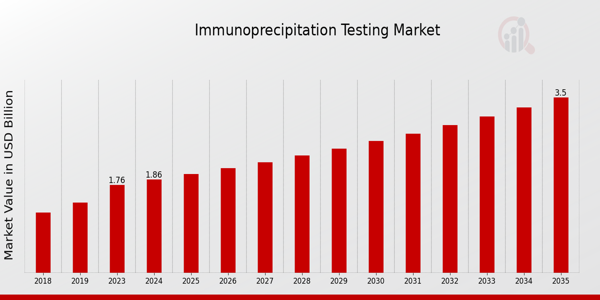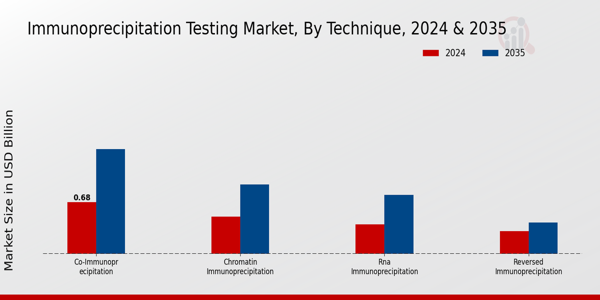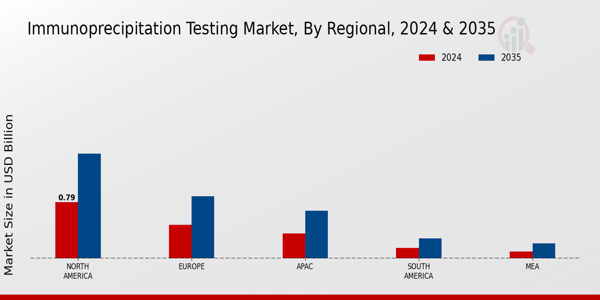Global Immunoprecipitation Testing Market Overview
As per MRFR analysis, the Immunoprecipitation Testing Market Size was estimated at 1.76 (USD Billion) in 2023. The Immunoprecipitation Testing Market is expected to grow from 1.86 (USD Billion) in 2024 to 3.5 (USD Billion) by 2035. The Immunoprecipitation Testing Market CAGR (growth rate) is expected to be around 5.89% during the forecast period (2025 - 2035).
Key Immunoprecipitation Testing Market Trends Highlighted
The growing need for personalized treatment and cutting-edge research methods are the main drivers of the global immunoprecipitation testing market's notable expansion. The demand for immunoprecipitation solutions has grown as scientists and medical practitioners have come to understand the significance of particular protein interactions in the pathophysiology of disease.
The use of immunoprecipitation as a vital technique for drug development and biomarker discovery is further supported by the rising incidence of chronic diseases as well as developments in biotechnology and pharmaceuticals. The market is growing as a result of rising investments in research and development across a range of industries, including academics and biotech firms.
There are several opportunities to be explored in the immunoprecipitation testing landscape. Emerging markets offer considerable potential due to their growing healthcare infrastructure and increasing focus on research initiatives. Additionally, integrating automation and digital technologies into immunoprecipitation processes can enhance efficiency and accuracy, attracting users who seek greater convenience and reliability in their research.
Collaborative projects between academia and industry could lead to innovative product development and broaden the application scope, particularly in clinical diagnostics and therapeutic development. Recent trends indicate a shift towards the use of high-throughput methods in immunoprecipitation testing, enabling researchers to process large volumes of samples with improved speed and efficiency.
Additionally, the rising emphasis on reproducibility and standardization in research emphasizes the need for reliable and consistent immunoprecipitation protocols and reagents. The evolution of multiplex immunoprecipitation techniques is also becoming popular, allowing simultaneous analysis of multiple proteins in one assay, thus maximizing research output and minimizing resource expenditure.
As the market adapts to these trends, the focus remains on enhancing the precision, ease, and applications of immunoprecipitation to meet the needs of diverse biomedical research and therapeutic areas.

Source: Primary Research, Secondary Research, MRFR Database and Analyst Review
Immunoprecipitation Testing Market Drivers
Growing Research in Biomedicine and Drug Development
The Global Immunoprecipitation Testing Market is primarily driven by the surge in research activities in biomedicine and drug development. Researchers utilize immunoprecipitation techniques for studying protein interactions, post-translational modifications, and complex cellular processes, which are fundamental to drug discovery and biological research.
The increasing focus on understanding disease mechanisms and the push towards personalized medicine are propelling investment in advanced diagnostic tools and methodologies, including immunoprecipitation.
As pharmaceutical companies aim to develop more effective therapies and target specific diseases, the demand for sophisticated immunoprecipitation testing increases, thereby driving market growth. Furthermore, the need for reproducible and reliable experimental results fosters innovation in immunoprecipitation methods, which enhances the capabilities of researchers in the field.
Collaborative efforts between academic institutions and biotechnology firms also contribute to a vibrant research environment, resulting in more applications for immunoprecipitation.
The continued advancements in proteomics and genomics are further fueling this growth, as they rely heavily on immunoprecipitation techniques for elucidating various aspects of molecular biology and proteomic analysis. With the anticipated expansion of life sciences research, the Global Immunoprecipitation Testing Market is poised for significant growth in the years ahead.
Rising Prevalence of Chronic Diseases
The rising prevalence of chronic diseases such as cancer, diabetes, and cardiovascular diseases is a critical driver of the Global Immunoprecipitation Testing Market. As these diseases become more common, the demand for precise diagnostic tools grows, making immunoprecipitation an essential technique.
These testing methods allow for the analysis of complex biological samples, enabling researchers and clinicians to understand diseases better, monitor progression, and develop effective treatment plans. Consequently, this uptick in chronic disease prevalence significantly boosts the immunoprecipitation testing market.
Technological Advancements in Immunoprecipitation Techniques
Improvements in technology have led to enhanced immunoprecipitation techniques, which are transforming the Global Immunoprecipitation Testing Market. Innovations such as automated systems, high-throughput screening capabilities, and advanced labeling methods are expanding the applicability and efficiency of immunoprecipitation testing.
These advancements make it easier to conduct large-scale experiments with improved accuracy and reduced time. As research requirements evolve, such technological progress plays a crucial role in driving market growth, providing researchers with the tools necessary to meet their analytical needs.
Immunoprecipitation Testing Market Segment Insights
Immunoprecipitation Testing Market Technique Insights
The Global Immunoprecipitation Testing Market focused on various techniques critical for protein analysis, with the Technique segment showcasing significant growth and development. The revenue generated from the different approaches within the Technique segment indicated a diversified field with increasing applications in research and development.
Co-Immunoprecipitation dominated this segment with a valuation of 0.68 USD Billion in 2024, rising to 1.37 USD Billion by 2035. Its popularity stemmed from its ability to study protein-protein interactions in complex biological samples, making it essential for understanding cellular functions and signaling pathways.
Chromatin Immunoprecipitation held a significant position in the market, with a value of 0.49 USD Billion in 2024, expected to grow to 0.91 USD Billion in 2035. This technique was pivotal for analyzing interactions between proteins and DNA and was widely used in epigenetics, enhancing its relevance in current biological research and diagnostics.
Meanwhile, RNA Immunoprecipitation contributed 0.39 USD Billion to the market in 2024, projected to reach 0.77 USD Billion by 2035. This technique was crucial for studying RNA-binding proteins, as it aided in uncovering the regulatory mechanisms of gene expression, thus offering vast opportunities for research in gene function and regulation.
Reversed Immunoprecipitation, though less dominant, holds a valuation of 0.3 USD Billion in 2024, with an increase to 0.41 USD Billion expected by 2035. This technique allowed for the isolation of proteins from specific cellular environments, which was vital in understanding molecular mechanisms.
Each of these techniques provided unique insights into cellular processes, contributing to advancements in biological research, personalized medicine, and therapeutic developments. The Global Immunoprecipitation Testing Market segmentation indicated a diverse range of methodologies, all pivotal in addressing ongoing and emerging challenges in molecular biology and biochemistry.
The combination of innovative technologies and increasing funding in research sectors are key growth drivers in this field, confirming the rising importance of these techniques in advancing scientific knowledge and application. Overall, the growth trajectory highlighted by Global Immunoprecipitation Testing Market data showcased a robust industry adapting to the needs of modern science and healthcare, driven by technological advancements and increased research focus.

Source: Primary Research, Secondary Research, MRFR Database and Analyst Review
Immunoprecipitation Testing Market Product Type Insights
Within this market, Product Type is a critical segmentation point encompassing various categories such as Kits, Reagents, Antibodies, and Magnetic Beads.
Kits are essential for providing comprehensive solutions, offering ease of use for both research and clinical applications, thus holding a majority share of the market. Reagents play a significant role as well, facilitating essential biochemical reactions in immunoprecipitation processes and supporting a range of laboratory applications.
Antibodies are particularly important due to their specificity and ability to target distinct proteins, thereby driving innovation in diagnostics and therapeutics. Meanwhile, Magnetic Beads are gaining traction for their efficiency in isolating and purifying biomolecules, making them a preferred choice among researchers.
Overall, the Global Immunoprecipitation Testing Market data illustrated a dynamic landscape with diverse opportunities and challenges driven by continuous technological advances and evolving end-user needs. The Global Immunoprecipitation Testing Market statistics reflect these trends, emphasizing the ongoing growth and potential within each Product Type category.
Immunoprecipitation Testing Market Application Insights
The Global Immunoprecipitation Testing Market is poised for growth, particularly within the Application segment, which comprises vital areas such as Drug Discovery, Genomics, Proteomics, and Diagnostics. Drug Discovery plays a crucial role, as it aids in identifying potential therapeutic targets, thus contributing to the development of new medications. Genomics is also significant, facilitating the understanding of genetic variations that may influence disease.
Proteomics, which involves studying proteins and their functions, is gaining traction for its applications in biomarker discovery and personalized medicine. Diagnostics is a dominant area within this market as well, offering essential tools for disease detection and monitoring. The continued advancements in technology and increased investment in research are driving the market forward while presenting opportunities for innovations.
As the market progresses toward 2035, expected growth is supported by the increasing demand for efficient and precise testing methodologies across various applications, underscoring the importance of the Global Immunoprecipitation Testing Market revenue, segmentation, data, statistics, and industry insights for stakeholders.
Immunoprecipitation Testing Market End User Insights
The growth can be attributed to increasing research activities and technological advancements across various sectors. The market segmentation reveals vital insights from end users such as Academic Research Institutions, Pharmaceutical and Biotechnology Companies, and Clinical Laboratories.
Academic Research Institutions represent a key segment, driving demand through fundamental research and explorative studies. Pharmaceutical and Biotechnology Companies are also crucial, as they utilize immunoprecipitation for drug development and quality control processes, leading to a substantial portion of market engagement.
Additionally, Clinical Laboratories play an important role in diagnostics and therapeutic assessments, further amplifying the market's value. The combined activities across these end-user segments contribute significantly to the Global Immunoprecipitation Testing Market revenue, indicating a robust framework supporting ongoing research and clinical practices needed in the industry.
Identifying growth drivers, such as technological innovations and increased funding for research, remains essential for stakeholders evaluating opportunities within this landscape.
Immunoprecipitation Testing Market Regional Insights
The Regional segment of the Global Immunoprecipitation Testing Market exhibited notable diversity in market valuations across various areas. In 2024, North America held a significant portion of the market, valued at 0.79 USD Billion, and is expected to grow to 1.47 USD Billion by 2035, indicating its majority holding in the market.
Europe followed with a valuation of 0.47 USD Billion in 2024, which is anticipated to rise to 0.87 USD Billion, showcasing its substantial contribution. The APAC region, valued at 0.35 USD Billion in 2024, is also witnessing growth, projected to reach 0.67 USD Billion.
South America and MEA represented smaller segments of the market, valued at 0.15 USD Billion and 0.1 USD Billion in 2024, respectively, but were still vital for market expansion strategies, with forecasts of reaching 0.28 USD Billion and 0.21 USD Billion by 2035.
The growth drivers in these regions included the increasing demand for research in biological studies and drug development, alongside rising investments in healthcare infrastructure. However, challenges such as regulatory barriers and market competition persist.
The statistics highlighted a competitive landscape with North America dominating due to its advanced research capabilities and funding opportunities, while other regions providee opportunities for growth, given the expanding need for immunoprecipitation testing across various sectors.

Source: Primary Research, Secondary Research, MRFR Database and Analyst Review
Immunoprecipitation Testing Market Key Players and Competitive Insights
The Global Immunoprecipitation Testing Market has experienced significant growth due to its crucial role in various fields such as molecular biology, biochemistry, and pharmaceuticals. As researchers and laboratories increasingly demand reliable and efficient tools for protein analysis, immunoprecipitation testing has become a fundamental technique for identifying and isolating specific proteins from complex mixtures.
Competitive dynamics within this market are characterized by innovation in assay technologies, the introduction of high-quality reagents, and advancements in automation. Key players are constantly striving to enhance their product offerings to meet the evolving needs of customers in research institutions, clinical laboratories, and biotechnology companies.
The competitive landscape is further shaped by strategic collaborations, mergers, and acquisitions, which strengthen the market position of incumbent players and facilitate the introduction of novel solutions. Thermo Fisher Scientific holds a prominent position in the Global Immunoprecipitation Testing Market, capitalizing on its vast portfolio of high-quality reagents, kits, and instruments that cater to various research applications.
The company is renowned for its innovative technologies, such as magnetic bead-based immunoprecipitation, which enhances specificity and yield in protein isolation procedures. Strengthened by a robust distribution network, Thermo Fisher Scientific effectively reaches a wide array of customers across the globe.
This extensive market presence is supported by strong branding, as well as collaborations with leading research institutions, fostering trust and credibility in its product offerings. Furthermore, the company emphasizes customer support and user-friendly protocols, further driving the adoption of its products in both academic and commercial settings, thus reinforcing its leadership in the market.
Abcam has established a strong foothold in the Global Immunoprecipitation Testing Market with a reputation for providing high-quality antibodies and reagents that are essential for successful immunoprecipitation experiments.
The company's strategic focus on research and development allows it to continually enhance its product offerings, ensuring that they meet the latest scientific standards and user needs. Abcam's commitment to quality is underpinned by rigorous validation processes that guarantee the specificity and sensitivity of its reagents, which are highly sought after by researchers.
Additionally, Abcam has built a strong online presence that facilitates easy access to product information and purchasing. This user-centric approach, combined with educational resources and technical support, positions Abcam as a trusted partner for researchers looking to implement immunoprecipitation as part of their workflows, consequently solidifying its competitive edge in the market.
Key Companies in the Immunoprecipitation Testing Market Include
- Thermo Fisher Scientific
- Abcam
- BioRad Laboratories
- Cayman Chemical
- Zyagen
- Proteintech Group
- Santa Cruz Biotechnology
- Cell Signaling Technology
- Pierce Biotechnology
- MilliporeSigma
- Takara Bio
- R and D Systems
- Affinity Biosciences
- GenScript
- New England Biolabs
Immunoprecipitation Testing Market Developments
Recent developments in the Global Immunoprecipitation Testing Market have seen significant advancements, particularly from key players such as Thermo Fisher Scientific, Abcam, and BioRad Laboratories.
These companies are enhancing their product offerings with new innovations, focusing on improving sensitivity and specificity in immunoprecipitation assays. The market is also witnessing a surge in demand due to the increasing prevalence of chronic diseases, which require advanced biomarkers for diagnosis and treatment.
Additionally, there are reports of mergers and acquisitions in the sector aimed at consolidating capabilities. For instance, recent activities surrounding Cayman's chemical portfolios reflect a strategic drive toward expanding their immunoprecipitation technologies. Companies like Cell Signaling Technology and New England Biolabs are also gaining traction through collaborations to leverage complementary technologies for better analytical outcomes. The market valuation
for these companies is reflecting growth due to heightened research activities in proteomics and antibody development, positioning the sector for robust expansion. As the global focus shifts towards precision medicine, the demand for reliable immunoprecipitation testing solutions continues to bolster the market landscape.
Immunoprecipitation Testing Market Segmentation Insights
Immunoprecipitation Testing Market Technique Outlook
- Co-Immunoprecipitation
- Chromatin Immunoprecipitation
- RNA Immunoprecipitation
- Reversed Immunoprecipitation
Immunoprecipitation Testing Market Product Type Outlook
- Kits
- Reagents
- Antibodies
- Magnetic Beads
Immunoprecipitation Testing Market Application Outlook
- Drug Discovery
- Genomics
- Proteomics
- Diagnostics
Immunoprecipitation Testing Market End User Outlook
- Academic Research Institutions
- Pharmaceutical and Biotechnology Companies
- Clinical Laboratories
Immunoprecipitation Testing Market Regional Outlook
- North America
- Europe
- South America
- Asia Pacific
- Middle East and Africa
| Attribute/Metric Source: |
Details |
| MARKET SIZE 2023 |
1.76(USD Billion) |
| MARKET SIZE 2024 |
1.86(USD Billion) |
| MARKET SIZE 2035 |
3.5(USD Billion) |
| COMPOUND ANNUAL GROWTH RATE (CAGR) |
5.89% (2025 - 2035) |
| REPORT COVERAGE |
Revenue Forecast, Competitive Landscape, Growth Factors, and Trends |
| BASE YEAR |
2024 |
| MARKET FORECAST PERIOD |
2025 - 2035 |
| HISTORICAL DATA |
2019 - 2024 |
| MARKET FORECAST UNITS |
USD Billion |
| KEY COMPANIES PROFILED |
Thermo Fisher Scientific, Abcam, BioRad Laboratories, Cayman Chemical, Zyagen, Proteintech Group, Santa Cruz Biotechnology, Cell Signaling Technology, Pierce Biotechnology, MilliporeSigma, Takara Bio, R and D Systems, Affinity Biosciences, GenScript, New England Biolabs |
| SEGMENTS COVERED |
Technique, Product Type, Application, End User, Regional |
| KEY MARKET OPPORTUNITIES |
Increasing demand for personalized medicine, Rising adoption in academic research, Growth in biotechnology and pharmaceutical industries, Advancements in antibody engineering technologies, Expanding applications in disease diagnostics |
| KEY MARKET DYNAMICS |
Increasing demand for research applications, Growth in biotechnology and pharma sectors, Advancements in immunoprecipitation technologies, Rising prevalence of chronic diseases, Government funding for research initiatives |
| COUNTRIES COVERED |
North America, Europe, APAC, South America, MEA |
Frequently Asked Questions (FAQ) :
The Global Immunoprecipitation Testing Market is expected to be valued at 1.86 USD Billion by 2024.
By 2035, the market size is anticipated to reach 3.5 USD Billion.
The expected CAGR for the market from 2025 to 2035 is 5.89%.
North America is projected to have the largest market share, valued at 0.79 USD Billion by 2024.
The Co-Immunoprecipitation technique is expected to be valued at 1.37 USD Billion by 2035.
Key players include Thermo Fisher Scientific, Abcam, BioRad Laboratories, and Santa Cruz Biotechnology.
The RNA Immunoprecipitation segment is valued at 0.39 USD Billion in 2024.
The APAC region is expected to show significant growth, reaching 0.67 USD Billion by 2035.
The Chromatin Immunoprecipitation technique is expected to generate 0.49 USD Billion by 2024.
The Reversed Immunoprecipitation technique is projected to be valued at 0.41 USD Billion by 2035.

















